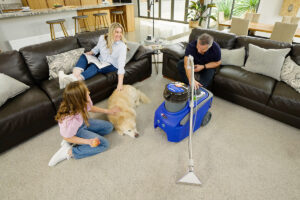Tips for a germ free home
Many of us work hard to create a home that is both beautiful and peaceful, a haven to kick back in and relax in at the end of a long day. At the moment, many of us are spending every hour of every day at home while we self-isolate. Some of us have time on our hands and are looking for jobs to do while some of us are flat out working from home while home schooling.
Whatever the case, it doesn’t hurt to put some time aside for some germ busting, so when you and the family do get the chance to put your feet up, you know your home is clean both ‘on’ and ‘under’ the surface.
Germs, as a matter of fact are everywhere and our homes are no exception. Some germs are friendly and important for helping our immune systems to develop, while other germs can cause serious illness. While it’s impossible to disinfect every place on earth (nor would we want too), there are some simple steps we can take at home to help reduce the level of germs and nasties lurking about. Here are a few tips to help reduce the level of germs in your home.
1) Schedule daily mini cleaning sessions
A little bit of cleaning and decluttering everyday goes a long way, especially when it comes to keeping the house germ-free. Clutter not only hides more clutter, it can also collect dust and attract dust mites. On top of this, it can serve as a breeding ground for bacteria, especially in moist environments like the kitchen. By scheduling mini decluttering or cleaning sessions, not only will you save effort in the long run (because you won’t have to clean the entire house in one fell swoop), you can also reduce those feelings of being overwhelmed when you do clean. Maintaining a germ-free and tidy household at any given time is a win-win.
Britex tip: Try scheduling mini cleaning tasks between short-breaks like tv commercial breaks or Netflix episodes. Get the kids to do their part too!
2) Pay attention to the kitchen
Bathroom aside, your kitchen is probably one of the dirtiest areas in your home, and with good reason! While many of us place great effort into disinfecting bathrooms, few dedicate the same attention to their kitchen. and here are a few key areas to look out for.
Chopping boards: Chopping boards, especially boards used for cutting raw meats, can be riddled with bacteria such as Salmonella and E. Coli. Studies have found that these essential items can harbour up to 200 times more bacteria than a toilet seat. While most of us wash our chopping boards after use, despite our best intentions, bacteria and germs can still survive in the small cracks on the board.
Britex tip: If your chopping board is looking old, replace it! Remember to separate chopping boards for raw meats and fresh produce. Use chopping boards made of glass or plastic as they are non-porous, most resistant to germs and can be thoroughly cleaned in the dishwasher. If you have a wooden chopping board, clean it thoroughly with hot running water while scrubbing it with a dish soap and sponge. Knife marks and scratches require extra scrubbing. Don’t forget to clean both sides of the board as meat juices can drip and be absorbed on both sides of the board.
Sponges: Dishwashing sponges are a hotbed for bacteria and germs to breed, and while most of us only go as far as rinsing our sponge, studies have shown that the density of bacteria within a sponge can reach up to 45 billion per square centimetre! Fret not, fortunately there’s an easy way to nuke (quite literally) your sponge of bacteria.
Britex tip: Simply saturate your sponge with some water, and microwave it for 1 to 2 minutes depending on the type of sponge it is. 1 minute for a scourer, 2 minutes for cellulose sponges. Remember, if it’s steel wool – do NOT put it in the microwave.
3) Surprise, surprise! It’s the bathroom
The bathroom immediately springs to mind when we think of the germiest areas in your home. Bathrooms are traditionally the one space where we spend most of our time cleaning and disinfecting, especially when it comes to the toilet and toilet seat. But what if you knew that there were other areas of the bathroom that harbour just as many germs (if not more) than your toilet seat?
Bathroom floors: Believe it or not, there could be more germs on the bathroom floor than the toilet seat. The problem is flushing, which results in microscopic faecal matter being sprayed into the air and landing on the floor or your bathroom mat. Coupled with the moist and cool environment of a bathroom and you have an absolute haven for bacteria and germs to thrive!
Britex tip: Remember to always close the toilet lid before you flush, and to mop your bathroom floor once a week with a bleach-based cleanser or disinfecting detergent. Also clean and dry any mats used in bathroom floors weekly to prevent mould and bacteria build-up.
Toothbrush – The human mouth contains about 100 million microbes per millimetre of saliva so it’s no surprise that every time you brush, food particles and bacteria inevitaby stick to your toothbrush, resulting in an overgrowth of bacteria over time.
Britex tip: After brushing, make it a habit to rinse your toothbrush in hot water to kill off any bacteria then and it up in a water glass to air-dry. Do not lay it on the counter where it can gather other bathroom germs, and definitely keep it far, far away from the toilet!
4) Deep cleaning carpets
Carpets are notorious for trapping all sorts of particles, from dirt to dust & pet dander, and while they look beautiful, often you don’t know what bacteria and germs are nestled deep within their fine fibres. While most of us adopt the “If I can’t see it, it ain’t dirty” mentality, your carpet is in fact a hotbed of bacteria, pollen, dead skin and dust. A microbiology research published in 2001 found an average indoor carpet to be about 4000 times dirtier than a toilet seat!
We all agree that carpet looks luxurious, is comfortable to lie on and is effective at insulating us from the heat and the cold. So we love it in our homes, but how do we maintain it? The good news is that regular vacuuming definitely helps remove some of the nasties. This coupled with deep cleaning with a hot water extraction system every 6 to 12 months can help to keep those germs and nasties at bay.
The Britex deep cleaning machine is one way to get started on carpet cleaning. Not only will you save time and money by taking the DIY route, you’ll be in control of your own carpet cleaning schedule and standards.
Britex tip: Did you know that using a Britex Carpet Cleaner with Britex Cleaning Solutions in a high traffic office area, has proven to reduce the bacterial load by up to 99.95%. We know that bacteria can act as a host to a range of viruses and nasties, so the less of it in our carpet, the better.
And while you’re carpet cleaning, consider tackling another one of the dirtiest parts of your home as well – your couch upholstery.
Fortunately, with the Britex deep cleaner and its interchangeable wand system, the Britex machine easily switches from carpet cleaning to upholstery cleaning, all with a simple changeover of a wand head and cleaning solution.
All Britex products are available at the Britex hire stand in Bunnings Warehouse, Woolworths, selected Coles, IGA, Mitre 10 and Home Hardware Stores.
Find your nearest store today!

5 Easy Ways to Keep Your Home Spotless This Christmas
December is here — the season of festive cheer, family, and… inevitable mess. One rogue wine glass, a muddy paw, or an overexcited nephew can

Get a Fresh Start for Summer: Smart Cleaning Tips to Refresh Your Home
You know summer’s on the way when the first warm breeze rolls in and suddenly your home feels like it’s been in hibernation. The sunlight

Hosting This Holiday Season? Avoid the Carpet Mistakes Guests Always Notice
It starts innocently enough. One minute you’re hanging fairy lights and feeling smug about being ahead of schedule, and the next you’re on your hands

Carpet Stain Removal Guide
Life can get messy. Let Britex take the guesswork out of stain and odour removal in your home, office and car!
